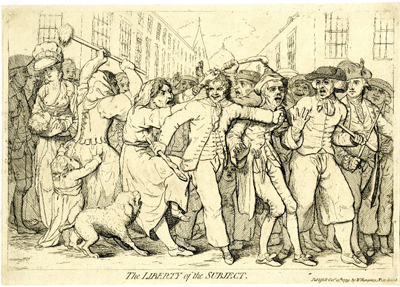The Liberty of the Subject
The Liberty of the Subject shows a naval press gang as it "recruits" a pathetic-looking tailor. The central sailor grabs the tailor's lapel, while another sailor grabs his left arm. The officer in charge looks on from the right with a drawn cutlass.
Military press gangs were especially active during the war with America in order to swell the ranks of the British army and navy. The enforcement of the Recruiting Act of 1778 in London may have, in fact, prompted this print.
This press gang, however, meets formidable resistance. A powerful looking woman (the tailor's wife?) has grabbed the central sailor by the hair and ear to prevent the tailor from being taken away. Another woman lends support with an upraised broom aimed at a member of the press gang. Bystanders look on with expressions ranging from enjoyment to indifference.

© Trustees of the British Museum
It is tempting to read the title of this print as deeply ironic and to see the print as a whole as a rather pointed comment on the infringement of British liberties by military press gangs. And that is certainly one component of the print. But as usual with Gillray it is not that simple. If this were really a simple attack on the practice on impressment, wouldn't the tailor hold the central position in the composition? And wouldn't he have been portrayed sympathetically? Instead, the tailor is pushed to the side and presented as pathetically weak and frightened. Indeed the central sailor seems almost to be protecting him from a termagant wife.
If there is any victim here it is this sailor who stands literally between the two opposing groups, compelled to enforce what appears to be a silly law that recruits the least likely candidates for service and who thereby suffers the barely contained wrath of people very much of his own class. What we see then is the liberty of a subject being constrained by a law and at the same time the potential dangers of liberty when unconstrained or insufficiently constrained.
Sources and Reading
- Commentary from the British Museum on The Liberty of the Subject
Comments & Corrections
NOTE: Comments and/or corrections are always appreciated. To make that easier, I have included a form below that you can use. I promise never to share any of the info provided without your express permission.